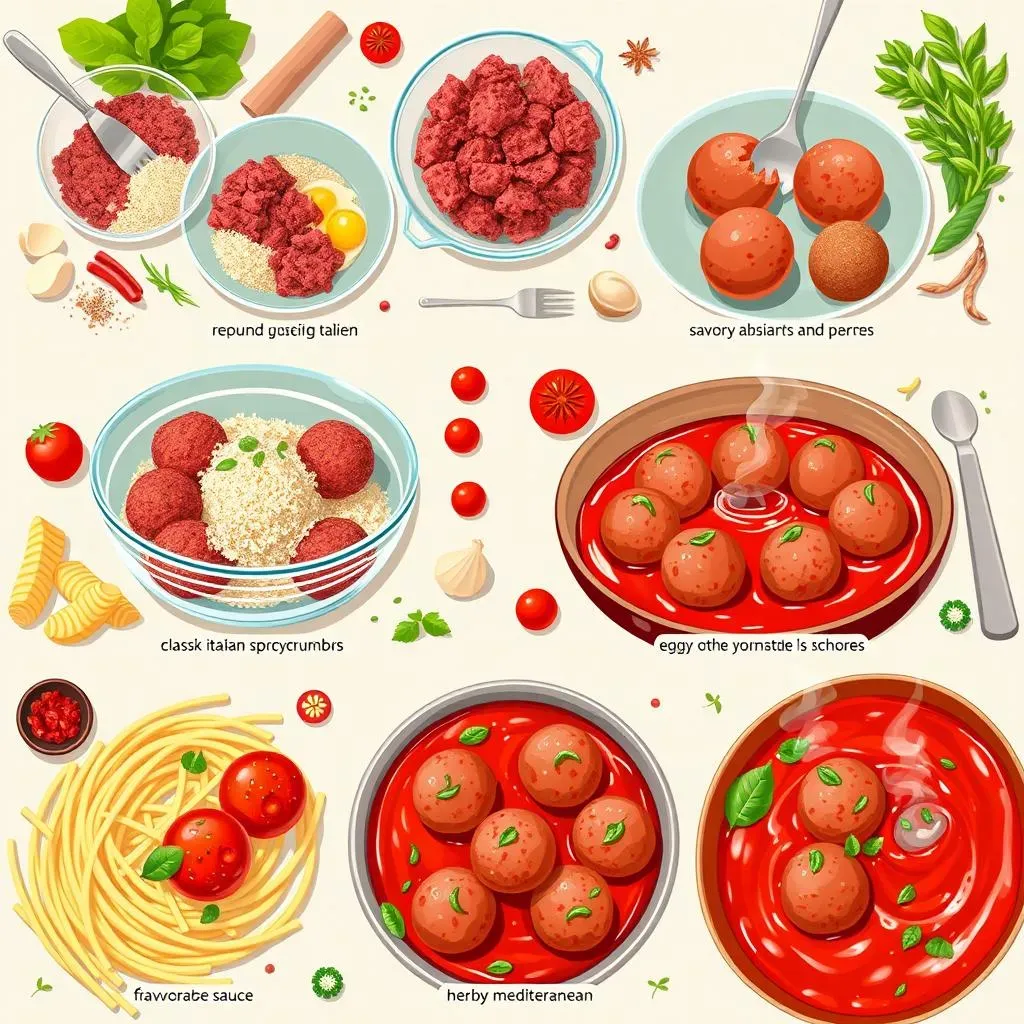Table of Contents
Are you ready to elevate your culinary game? This comprehensive guide dives headfirst into the delicious world of ground beef meatball recipes. Whether you're a seasoned chef or a kitchen novice, you'll find something to inspire you here. We'll explore the fundamental techniques that guarantee juicy, flavorful meatballs every single time, from selecting the perfect ground beef to mastering the art of simmering in rich sauces. This isn't just another collection of recipes; it's a journey into the heart of meatball-making, covering everything from classic Italian recipes to exciting global variations. Prepare to discover the secrets to perfectly browned exteriors and tender, succulent interiors. We'll tackle common meatball mishaps, providing solutions and tips to ensure your success. Get ready to impress your friends and family with your newfound meatball expertise! This ultimate guide to ground beef meatball recipes promises to be your go-to resource for creating unforgettable meals. So, let's get started and unlock the full potential of those humble ground beef meatballs!
Mastering the Art of Ground Beef Meatballs: From Classic to Creative

Mastering the Art of Ground Beef Meatballs: From Classic to Creative
Understanding the Fundamentals
So, you're diving into the wonderful world of ground beef meatballs? Fantastic! Let's start with the basics. The key to a truly amazing meatball lies in the balance of ingredients. Think of it like a perfectly tuned engine – each part plays a crucial role. We'll explore the importance of choosing the right ground beef – leanness versus fat content makes a huge difference in the final product's juiciness. We'll also discuss the role of binders (like breadcrumbs or oats), the magic of seasonings, and the impact of different liquids (milk, eggs, or even broth). Getting this foundational knowledge right is the first step to creating truly outstanding meatballs.
Next, we’ll explore classic meatball techniques. We’ll cover the art of gently mixing the ingredients (overmixing is a common mistake!), forming perfectly sized balls, and choosing the best cooking method – baking, frying, or simmering in sauce. Each method delivers a unique texture and flavor profile. We’ll also delve into the secrets of creating a delicious and flavorful meatball sauce, whether it's a classic marinara or a more adventurous option. For those looking to experiment, we'll share tips on making your own breadcrumbs for added texture and flavor. Check out our guide on for even better results!
Ingredient | Role | Considerations |
|---|---|---|
Ground Beef | Flavor & Texture | 80/20 blend is ideal for juiciness |
Breadcrumbs | Binder & Texture | Panko or Italian-style work well |
Egg | Binder & Moisture | Adds richness and helps hold shape |
Exploring Flavor Profiles
Once you've mastered the fundamentals, it's time to get creative! Ground beef meatballs are incredibly versatile. We'll explore a range of flavor profiles, starting with the beloved classic Italian meatball. We'll then venture into other exciting culinary landscapes, showcasing how simple ingredient swaps can transform your meatballs into something truly unique. Consider adding herbs and spices to create a Mediterranean twist, or experiment with different cheeses for added richness and complexity. The possibilities are endless!
From spicy Southwestern flavors to savory Asian-inspired creations, we'll show you how to adapt these basic techniques to create a variety of exciting and delicious ground beef meatballs. We will also look at some healthy alternatives, such as using turkey or chicken instead of beef, or incorporating vegetables for added nutrition. For a quick and easy meal, our is a perfect choice. And if you're looking for something a bit different, why not try our recipe?
- Classic Italian
- Spicy Mexican
- Savory Asian
- Herby Mediterranean
Ground Beef Meatball Recipes: Tips, Tricks, and Troubleshooting

Ground Beef Meatball Recipes: Tips, Tricks, and Troubleshooting
Avoiding Common Meatball Mistakes
Let's be honest, even experienced cooks have their meatball mishaps. One of the most common problems is dry, crumbly meatballs. This often happens when the meat mixture is over-mixed, squeezing out precious moisture. The solution? Gentle handling is key! Mix your ingredients just until combined. Overmixing develops the gluten in the meat, making for tough meatballs. Another frequent issue is uneven cooking. To avoid this, ensure your meatballs are all roughly the same size before cooking. Using a cookie scoop helps achieve consistency. And finally, don't overcrowd your pan or baking sheet when cooking. This restricts air circulation and leads to uneven browning and potentially soggy meatballs. For more tips on achieving perfect consistency, check out our article on .
Another frequent question is about freezing meatballs. Freezing raw or cooked meatballs is a fantastic way to meal prep. If freezing cooked meatballs, ensure they are completely cool before storing them in freezer bags to prevent freezer burn. Raw meatballs can be frozen on a baking sheet before transferring them to a bag to maintain their shape. Remember to label and date your bags for easy identification. For more detailed instructions on freezing and thawing, you can find our guide on . Proper freezing and thawing techniques will prevent your meatballs from drying out.
- Don't overmix the meat
- Use a cookie scoop for even meatballs
- Don't overcrowd the pan
Seasoning and Flavor Enhancement
The flavor of your meatballs is just as important as their texture. Don't be afraid to experiment with different herbs and spices to create unique flavor profiles. A simple addition of fresh herbs like parsley, oregano, or basil can elevate a classic Italian meatball. For a spicier kick, consider adding red pepper flakes or a dash of your favorite hot sauce. Don't forget the power of aromatics! Sautéing onions and garlic before adding them to the meat mixture adds depth and complexity to your meatballs. For some inspiration, check out our article. Experiment with different herbs and spices to find your perfect combination.
Another way to add flavor is to incorporate different cheeses into your meatball mixture. Parmesan is a classic choice, but you can also experiment with mozzarella, provolone, or even feta, depending on the desired flavor profile. Remember that the cheese will melt and add moisture to the meatballs, so don't overdo it! You can also add a splash of Worcestershire sauce or soy sauce for an umami boost. And if you're feeling adventurous, try adding a touch of sweetness with a little brown sugar or maple syrup. For a healthier option, explore our comparison. Don't be afraid to get creative and experiment with different flavor combinations.
Flavor Profile | Herbs/Spices | Cheese |
|---|---|---|
Classic Italian | Oregano, Basil, Parsley | Parmesan |
Spicy Mexican | Chili powder, Cumin, Cayenne | Monterey Jack |
Asian-inspired | Ginger, Garlic, Soy Sauce | None or a sharp cheddar |
Cooking Methods and Serving Suggestions
The method you choose to cook your meatballs will significantly impact their final texture and flavor. Baking is a great option for even cooking and easy cleanup. Frying delivers a crispy exterior, but requires more attention to prevent burning. Simmering in sauce creates tender, flavorful meatballs, and is a classic approach. Whichever method you choose, be sure to cook your meatballs to an internal temperature of 160°F (71°C) to ensure they are fully cooked and safe to eat. For a complete guide to reheating, take a look at our article on . Choose the cooking method that best suits your preferences and time constraints.
Finally, don't forget about the importance of serving suggestions. Classic Italian meatballs are delicious served over spaghetti with marinara sauce. But don't limit yourself! These versatile meatballs can be used in a variety of dishes. Consider adding them to soups, stews, or casseroles. They can also be served as appetizers with toothpicks, or used as toppings for pizzas or salads. For some creative ideas, check out our article. Let your creativity run wild and experiment with different serving options.
Beyond the Basics: Exploring Diverse Ground Beef Meatball Recipes

Beyond the Basics: Exploring Diverse Ground Beef Meatball Recipes
Global Meatball Fusion
Now that we've covered the fundamentals, let's unleash your inner culinary explorer! Ground beef meatballs aren't confined to Italian-American cuisine. Think of the possibilities: imagine the vibrant spices of a Moroccan tagine, the fragrant herbs of a Greek-inspired dish, or the bold flavors of a Southwestern chili. A simple swap of herbs and spices can transform your meatballs into a culinary passport, transporting your taste buds across continents. For instance, a dash of cumin, chili powder, and smoked paprika can easily morph your meatballs into a spicy Southwestern delight, perfect for a taco filling or a hearty chili. Let's not forget about the incredible versatility of sauces. A creamy peanut sauce, a tangy barbecue glaze, or a sweet-and-sour reduction can open up a world of flavor combinations. The key is to experiment and have fun! Don't be afraid to step outside your comfort zone and try something new. For some truly unique ideas, check out our article on .
Consider the textures too! Instead of traditional breadcrumbs, experiment with crushed nuts, almond flour, or even finely grated vegetables for a unique twist. These additions not only change the texture but also subtly shift the flavor profile. Think about adding finely diced vegetables directly into the meat mixture. Carrots, zucchini, and bell peppers add moisture and nutritional value while contributing a mild sweetness. For a hearty and satisfying meal, our recipe is a great choice. And if you're looking for a healthier option, explore our article on .
- Moroccan Spiced Meatballs
- Greek Lemon-Herb Meatballs
- Southwestern Chili Meatballs
- Asian-Glazed Meatballs
Dietary Adaptations and Creative Twists
Let's talk about dietary needs and preferences. Not everyone can or wants to eat traditional meatballs. But that doesn't mean they have to miss out! With a few simple adjustments, you can easily adapt ground beef meatball recipes to suit various dietary restrictions. For those following a low-carb or ketogenic diet, substituting traditional breadcrumbs with almond flour or pork rinds is a simple solution. For gluten-free options, ensure your breadcrumbs are certified gluten-free. Similarly, for dairy-free versions, simply omit the cheese or use dairy-free alternatives. Don't be afraid to get creative and experiment with different ingredients!
And for those seeking healthier choices, using leaner ground beef or incorporating more vegetables into the mixture is a great way to boost the nutritional value of your meatballs without sacrificing flavor. You can also experiment with different proteins, such as ground turkey or chicken, to create leaner alternatives. Furthermore, consider adding different grains or legumes to the mixture to add fiber and nutrients. Quinoa, lentils, or even finely chopped mushrooms can be used to add bulk and enhance the nutritional profile of your meatballs. For more ideas on healthy substitutions, check out our article on . Remember that even small changes can significantly impact the overall nutritional value of your dish.
Dietary Need | Adaptation |
|---|---|
Low-Carb/Keto | Almond flour or pork rinds instead of breadcrumbs |
Gluten-Free | Certified gluten-free breadcrumbs |
Dairy-Free | Omit cheese or use dairy-free alternatives |